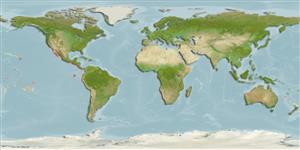分类 / Names
俗名 | 同种异名 | Catalog of Fishes(属, 种) | ITIS | CoL | WoRMS | Cloffa
Teleostei >
Beloniformes (Needle fishes) >
Hemiramphidae (Halfbeaks)
Etymology: Hyporhamphus: Greek, hypo = under + Greek, rhamphos = beak, bill (Ref. 45335); naos: Named for the Naos Island, Bay of Panama, where the species is common and the site ot the Smithsonian Tropical Research Institute (STRI) Marine Laboratory.
Environment: milieu / climate zone / depth range / distribution range
生态学
海洋; 半咸淡水; 深度上下限 0 - ? m. 熱帶
Eastern Pacific: from Baja California, with strays north to San Diego, CA, south to Paita, Peru and in the Galapagos Islands.
中太平洋東部: 巴拿馬。
大小 / 重量 / 年龄
Maturity: Lm ? range ? - ? cm
Max length : 29.0 cm SL 雄鱼/尚未辨别雌雄; (Ref. 96012); 最大体重: 74.50 g (Ref. 96012)
背的软条 (总数) : 12 - 16. This species is distinguished by the following characters: dorsal and anal fin bases of adults are covered with scales; first gill arch rakers total 29-39, second gill arch rakers total 21-28; pelvic to caudal extension falls anterior to opercle and posterior to upper jaw; for continental population, pelvic to caudal distance usually 0.44-0.47 to SL; preorbital length to orbital diameter usually greater than 0.70 (in 81% of 119 specimens examined) (Ref. 42105).
Inhabits inshore, coastal and estuarine; found along sand beaches, in lower tidal streams and mangroves. Usually encountered in schools at the surface of the water (ref. 42105).
Life cycle and mating behavior
成熟度 | 繁殖 | 产卵场 | 卵 | 孕卵数 | 仔鱼
中太平洋東部: 巴拿馬。
Banford, H.M. and B.B. Collette, 2001. A new species of halfbeak, Hyporhamphus naos (Beloniformes: Hemiramphidae), from the tropical eastern Pacific. Rev. Biol. Trop. 49(1):39-49. (Ref. 42105)
世界自然保护联盟红皮书 (Ref. 130435: Version 2024-2)
人类利用
工具
特别资料
下载 XML
网络资源
Estimates based on models
Phylogenetic diversity index (Ref.
82804): PD
50 = 0.5000 [Uniqueness, from 0.5 = low to 2.0 = high].
Bayesian length-weight: a=0.00240 (0.00132 - 0.00435), b=3.11 (2.96 - 3.26), in cm total length, based on LWR estimates for this species & Genus-body shape (Ref.
93245).
营养阶层 (Ref.
69278): 3.0 ±0.4 se; based on size and trophs of closest relatives
回复力 (Ref.
120179): 高度, 族群倍增时间少于 15个月 (Preliminary K or Fecundity.).
Fishing Vulnerability (Ref.
59153): Low to moderate vulnerability (25 of 100).
